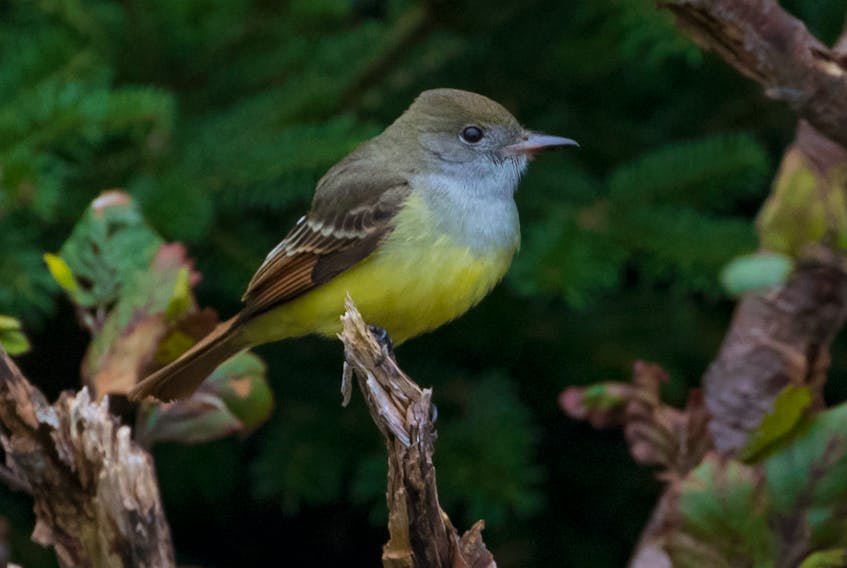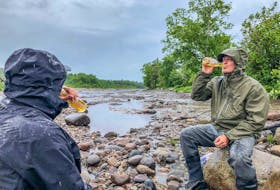Oh yes, autumn is the season for rare bird hunters.
After a slow start to September, October opened with a spectacular weather system. Southern air pumped north by far reaching winds shifted to a 48-hour period of strong southwest winds engulfing the Avalon Peninsula with record warmth and humidity.
To birders who regularly follow the weather maps it looked spectacular with a huge sharply defined front and strong winds from the eastern United States to the Avalon.
As we hoped the Avalon Peninsula received a jumbo order of wind drifted waifs.
One of the first signs something interesting had happened was a blue grosbeak hopping about on paved walkway at the tip of Cape Spear. It was a brown-coloured, immature bird but still highly desired by the local birding community as a must-see bird. It turned out to be co-operative as it went about its business of eating weed seeds.
A few dozen birders were privileged to enjoy this southern finch. The sharp-eyed birders attracted to Cape Spear by the blue grosbeak picked out a couple of Baltimore orioles and scattered rare warblers like northern parula, blackburnian warbler and prairie warbler in the isolated fir trees between the parking lot and lighthouse.
Just a little south of the lighthouse on the east coast trail there is a patch of gnarly woods where birders found a rare white-eyed vireo, an ovenbird. more orioles and a scarlet tanager.
A day later Ken Knowles and I had a most amazing experience in the old gravel pit at Bear Cove south of Renews.
This location is famous among birders for rare birds. Standing in one place we saw a virtual flock of rarities.
There was a Philadelphia vireo, warbling vireo, four red-eyed vireos and two rose-breasted grosbeaks.
But the cream of the crop came nearby in Cappahayden where, along with John Wells, we discovered a great crested flycatcher.
This bird is quite rare in Newfoundland being seen on average maybe once every four or five years. It is fairly common in its eastern United States range. Being a large flycatcher it has a bright yellow belly and steely-grey breast and rufous coloured tail. This bird drew a number of St. John’s birders to Cappahayden before dark. Most of the rest came the next morning.
This is when things got a little out of hand.
I was with Jared Clarke looking at the great crested flycatcher early this morning when suddenly we realized there were two of them.
Two great crested flycatchers sat near each other in the same tree! A sight never imagined possible in this province.
Everyone who came got their looks.
It was a new bird for just about everyone.
But it got even crazier when Jared and I found a third great crested flycatcher in a gravel pit over grown with alders a kilometre south of Cappahayden.
Have you ever had that sky-is-falling feeling? We started giggling. This was way off the charts.
Then a report came over the birder’s WhatsApp bird line. It was from Les Sweetapple and Keith Fillier on Powles Head near Trepassey. They had seen two white-eyed vireos. One per fall is the provincial standard but two in the same day had never happened before.
The number two turned out to be the theme of the day for Jared and I. We saw two scarlet tanagers in the same tree in Cappahayden adding to the three or four already sighted elsewhere on the Avalon in the previous couple of days.
On Bear Cove point road near Renews we had spectacular views of two yellow-billed cuckoos searching for large insects and caterpillars low in the alders along the roadside doubling the autumn’s total. Our two indigo buntings for the day tamely fed on roadside weeds. We birded until dark. It felt like there was another rare bird waiting in the next alder patch.
Everyone out birding on this day had memorable experience.
This is a continuing story. The extraordinary rare bird hunting should continue for a few more days at least.
Most of these birds will turn around on the next clear night and head back to the eastern United States to resume their southern migration.
However, a good many should linger providing easy targets for the rarity hunters. Even if you are not a rare bird hunter you could stumble across a rare bird in your backyard or while out walking. Keep an eye on any fruiting trees in your rounds for an oriole or scarlet tanager. I expect yellow-billed cuckoos to start showing up in random backyards on the Avalon.
We are heading into the Thanksgiving Weekend with high hopes.
These are the good old days of autumn rarity hunting.
Bruce Mactavish is an environmental consultant and avid birdwatcher. He can be reached at [email protected].









